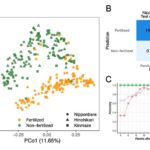
In a groundbreaking study that promises to reshape our understanding of autism spectrum disorder (ASD), researchers have employed state-of-the-art single-cell genomic technologies to unravel the complex molecular alterations underlying dup15q syndrome—a genetic condition strongly linked to autism. This pioneering work, recently published in Nature Communications, offers an unprecedented glimpse into the developmental and postnatal changes occurring at the cellular level in the brains of individuals with this syndrome, setting the stage for novel therapeutic directions and diagnostic tools.
Dup15q syndrome is characterized by a duplication of a segment on chromosome 15, and it stands as one of the most common genetic abnormalities associated with autism. Although the clinical diagnosis of dup15q has been recognized for years, the precise molecular pathways it disrupts remained elusive until now. By leveraging single-cell RNA sequencing and chromatin accessibility assays, the research team led by Perez, Velmeshev, and Wang has meticulously dissected the brain’s cellular composition and gene regulatory networks, effectively decoding the cascading molecular events that arise from this chromosomal anomaly.
Single-cell analysis has revolutionized genomics by enabling the examination of gene expression and epigenetic states in thousands of individual cells simultaneously. This technology allowed the researchers to bypass the averaging effects of bulk tissue studies, which often mask crucial variations between cell types. In this study, the scientists analyzed brain tissue samples from individuals diagnosed with dup15q syndrome alongside neurotypical controls, ensuring that their findings reflect disease-specific alterations rather than background variability.
.adsslot_Q0SLYxJqfM{width:728px !important;height:90px !important;}
@media(max-width:1199px){ .adsslot_Q0SLYxJqfM{width:468px !important;height:60px !important;}
}
@media(max-width:767px){ .adsslot_Q0SLYxJqfM{width:320px !important;height:50px !important;}
}
ADVERTISEMENT
The research exposed a remarkable reorganization in the developmental trajectories of neuronal and glial populations within the affected brains. Among the crucial revelations was the alteration in expression patterns of genes involved in synaptic signaling, neural connectivity, and immune response modulation. Notably, excitatory neurons—a cell type critical for transmitting information across neural circuits—displayed disrupted maturation pathways that could underlie the cognitive and behavioral impairments seen in ASD.
What distinguishes this study even further is the identification of molecular changes not only during early brain development but extending into the postnatal period. Previous models of autism primarily focused on prenatal disruptions, but these new findings suggest an ongoing pathological process that continues well after birth. This insight challenges existing paradigms and highlights a potential window for therapeutic intervention that broadens beyond prenatal care.
Deep within the analyzed single-cell datasets, significant dysregulation of long non-coding RNAs and microRNAs was also evident. These molecules, once considered “junk” DNA, have increasingly been recognized as pivotal regulators of gene expression. Their aberrant activity in dup15q brains enhances our understanding of the epigenetic complexity at play and opens new avenues for RNA-based therapies.
Additionally, the study sheds light on the role of glial cells—particularly astrocytes and microglia—in the pathophysiology of dup15q-related autism. Traditionally overshadowed by neurons in autism research, glial cells contribute to maintaining homeostasis and immune surveillance in the central nervous system. The altered gene expression profiles observed in these cells indicate a pro-inflammatory state that could exacerbate neuronal dysfunction, a concept compatible with emerging views on neuroinflammation in autism.
From a technical standpoint, Perez and colleagues utilized integrative multi-omics approaches to cross-validate their findings. Combining transcriptomics with epigenomic profiling at single-cell resolution provided a multidimensional view of gene regulation. This integrative approach revealed disruptions in enhancer-promoter contacts and chromatin remodeling enzymes previously unassociated with ASD, unraveling the intricate epigenetic architecture that governs brain development.
The implications of this study go beyond the laboratory. By generating a detailed cellular atlas of dup15q syndrome, the researchers have created a resource that clinicians and drug developers can use to design targeted interventions. Precision medicine approaches tailored to specific cell types and molecular pathways will likely emerge, increasing the efficacy of treatments for individuals carrying this genetic duplication.
Moreover, the work contributes to the ongoing dialogue about autism’s heterogeneity. Autism is a spectrum disorder, and molecularly unpacking its various subtypes is critical to overcoming the limitations of broad diagnostic categories. The unique signatures identified in the dup15q subgroup provide a model for dissecting the biology of other genetic forms of autism using similar single-cell methodologies.
The study also addresses a critical need for biomarkers that can be detected non-invasively. Some of the molecular changes pinpointed in the brain show promise for correlation with peripheral cells or biofluids, suggesting the potential development of early diagnostic tests based on blood samples or cerebrospinal fluid profiles. Such advancements could drastically improve early detection and intervention outcomes in autism.
In addition, the research highlights the dynamic interplay between genetic predisposition and environmental factors, as the postnatal molecular alterations might reflect ongoing gene-environment interactions. Understanding how external influences modulate gene expression during critical periods of brain plasticity provides a more holistic picture of autism pathogenesis.
Based on these findings, the authors advocate for a reconsideration of therapeutic strategies. Instead of focusing solely on early developmental disruptions, treatments could be designed to modulate gene expression and immune function across different life stages, potentially improving cognitive and behavioral profiles even beyond early childhood.
This transformative single-cell study also symbolizes the broader shift in neuroscience research towards higher resolution, data-rich, and integrative biological investigations. The power of combining cutting-edge technology with clinical insight opens new frontiers in deciphering complex brain disorders, offering hope to millions affected by autism worldwide.
The originality, depth, and technical rigor of this work make it a landmark contribution to ASD research. As the scientific community digests these insights, the path forward is clearer yet fraught with challenges—translating molecular knowledge into effective clinical applications demands interdisciplinary collaboration, robust validation, and ethical foresight.
In summary, the single-cell molecular roadmap laid out by Perez and colleagues in dup15q syndrome not only deepens our understanding of autism’s biological underpinnings but also revitalizes hope for personalized medicine approaches. As these molecular narratives unfold, they promise to revolutionize how we diagnose, treat, and conceptualize autism for decades to come.
Subject of Research: Single-cell molecular and developmental analysis of dup15q syndrome in autism spectrum disorder
Article Title: Single-cell analysis of dup15q syndrome reveals developmental and postnatal molecular changes in autism
Article References:
Perez, Y., Velmeshev, D., Wang, L. et al. Single-cell analysis of dup15q syndrome reveals developmental and postnatal molecular changes in autism.
Nat Commun 16, 6177 (2025). https://doi.org/10.1038/s41467-025-61184-4
Image Credits: AI Generated
Tags: brain cellular composition analysischromosome 15 duplicationdiagnostic tools for dup15q syndromedup15q syndrome autism researchepigenetic changes in autismgene regulatory networks in autismgenetic abnormalities associated with autismmolecular alterations in autismsingle-cell genomic technologiessingle-cell RNA sequencing techniquestherapeutic directions for autism



